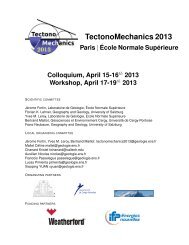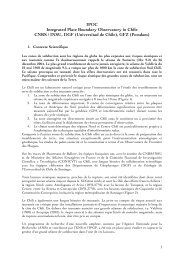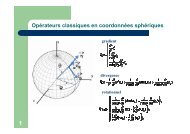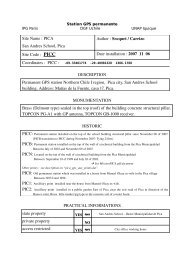PDF file - Laboratoire de Géologie de l'Ecole normale supérieure - Ens
PDF file - Laboratoire de Géologie de l'Ecole normale supérieure - Ens
PDF file - Laboratoire de Géologie de l'Ecole normale supérieure - Ens
Create successful ePaper yourself
Turn your PDF publications into a flip-book with our unique Google optimized e-Paper software.
5<br />
SOCQUET ET AL.: GPS MEASUREMENTS TO REFINE INDIA/SUNDA RELATIVE MOTION<br />
Eurasia, the Indian Plate rotates anticlockwise about a<br />
pole located at 27.5°N, 12.9°E at a rate of 0.398°/Ma.<br />
Our pole <strong>de</strong>termination predicts a velocity at Bangalore<br />
(IISC) of 39 mm/yr oriented N25°. This is 20% slower<br />
than the 48 mm/yr oriented N21° predicted by NNR-<br />
Nuvel1A mo<strong>de</strong>l [DeMets, et al., 1990; DeMets, et al.,<br />
1994]. It is also ~5 mm/yr slower than the 44 mm/yr<br />
oriented N22° at IISC given by the latest previous<br />
geo<strong>de</strong>tic study [Paul, et al., 2001]. This difference is<br />
probably due to the use of a different reference frame<br />
for the two GPS solutions (ITRF-2000 versus ITRF-96).<br />
Also, the technique used by [Paul et al., 2001] to map<br />
their velocities in ITRF-96 (by applying tight<br />
constraints to the coordinates of IISC, KIT3 and POL2)<br />
may have forced IISC velocity. In<strong>de</strong>ed IISC velocity is<br />
slower by 2 mm/yr northward and faster by 2 mm/yr<br />
eastward in ITRF-2000 than in ITRF-96. It is quite<br />
noticeable that as the <strong>de</strong>termination of the ITRF is<br />
refined, the geo<strong>de</strong>tic estimate of the India/Eurasia<br />
motion <strong>de</strong>creases and becomes more oblique.<br />
4.2. Sunda – India relative pole <strong>de</strong>termination<br />
To <strong>de</strong>termine the rotation pole between Indian and<br />
Sunda plates, we rotate our velocities with respect to the<br />
previously <strong>de</strong>fined Indian Plate and minimize, in the<br />
least square sense, the velocities of the stations located<br />
on the Sunda Plate. The stations located close to the<br />
block boundaries, potentially affected by significant<br />
elastic <strong>de</strong>formation or located in seismically active<br />
regions were not selected for the pole <strong>de</strong>termination<br />
Figure 3: Vector components of the residual velocities<br />
used for the India / Sunda pole <strong>de</strong>termination. Units are<br />
in mm/yr. 73% of the stations display residual velocities<br />
below 3 mm/yr (circle), the remaining ones being<br />
located close to the plate’s boundaries.<br />
(Eastern margin of Borneo, Java Island, south<br />
Sumatran shore). Stations displaying a residual<br />
velocity higher than 10 mm/yr have been removed too.<br />
These non-consistent velocities are mainly the APRGP<br />
stations, most of which have been measured only twice<br />
with a year interval, and thus display important<br />
uncertainties (Table S4). This leaves us with 33<br />
stations used for the pole <strong>de</strong>termination (PHON,<br />
TAUN, OTRI, VIEN, HPAA, NONN, UTHA, SRIS,<br />
KHON, CHON in Indochina, BANH, PHUK, ARAU,<br />
IPOH, KTPK, GETI, DOP4, SEGA, KUAL, KUAN,<br />
UTMJ, NTUS, TANJ in the Malaysian peninsula,<br />
TABA, KUCH, BINT, MIRI, BATU, BRUN, LABU,<br />
KINA, D005, PUER in Borneo). The relative rotation<br />
pole between the Sunda Plate and the Indian Plate is<br />
located in North Africa (20.2° N, 26.1° E) and rotates<br />
clockwise at a rate of 0.370 °/Ma. The error ellipse is<br />
oriented N158°, has a 2.11°-long semi-major axis and<br />
a 0.39°-long semi-minor axis, which means that the<br />
longitu<strong>de</strong> of the pole is better constrained than its<br />
latitu<strong>de</strong>. The residual velocities of Sunda stations with<br />
respect to this pole are listed in Table S4. As shown in<br />
Fig. 3, the residual velocities at stations used for the<br />
pole <strong>de</strong>termination are small (50% < 2 mm/yr) and<br />
have no preferential orientation. Therefore, we<br />
consi<strong>de</strong>r that we reached a robust estimate of the<br />
relative India/Sunda motion, more accurate than<br />
previous solutions since it inclu<strong>de</strong>s far more stations<br />
over rigid Sunda, and takes into account the slower<br />
motion of India – 5 mm/yr slower than [Paul et al.,<br />
2001]. Our new pole predicts a relative India / Sunda<br />
motion along the Arakan Trench of 35 mm/yr with a<br />
N11° azimuth in central Myanmar (22°N), and of 36<br />
mm/yr with a N14° azimuth in southern Myanmar<br />
(17°N).<br />
5. Deformation at the plate boundary<br />
5.1. GPS velocity field in Myanmar<br />
Myanmar GPS velocities are shown in Fig. 4 in the<br />
new Sunda reference frame, together with the active<br />
fault traces and the available earthquake focal<br />
mechanisms. At the latitu<strong>de</strong> ~22°N and east of the<br />
Sagaing Fault, YWEN station moves at 6 mm/yr with<br />
respect to the Sunda Plate. The motion of YWEN is<br />
possibly affected by elastic strain loading due to<br />
coupling on the Sagaing Fault. The westward<br />
component of motion is however best explained by<br />
intracontinental <strong>de</strong>formation at the northern edge of the<br />
Indochinese peninsula, due to clockwise rotations<br />
evi<strong>de</strong>nced around the Eastern Himalayan Syntaxis<br />
[Holt, et al., 1991; Ratschbacher, et al., 1996; Wang, et<br />
al., 1998]. This rotational pattern generates shear on<br />
the northern edge of the Indochinese peninsula (in<br />
Yunnan, China) that is accommodated along E-W leftlateral<br />
strike-slip faults [Lacassin, et al., 1998; Socquet






